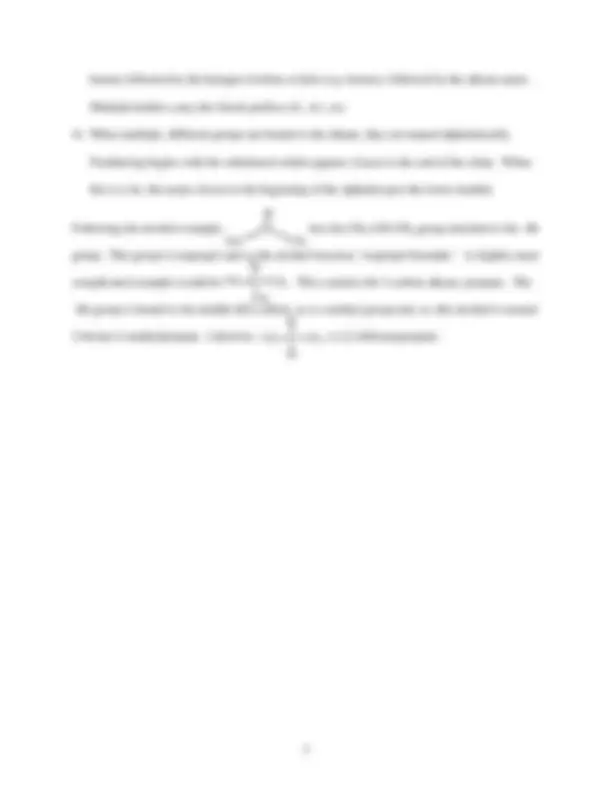



Study with the several resources on Docsity

Earn points by helping other students or get them with a premium plan


Prepare for your exams
Study with the several resources on Docsity

Earn points to download
Earn points by helping other students or get them with a premium plan
Community
Ask the community for help and clear up your study doubts
Discover the best universities in your country according to Docsity users
Free resources
Download our free guides on studying techniques, anxiety management strategies, and thesis advice from Docsity tutors
Material Type: Notes; Class: Prin Chem Honor Lab II; Subject: Chemistry; University: Marshall ; Term: Unknown 1989;
Typology: Study notes
1 / 3

This page cannot be seen from the preview
Don't miss anything!


Structure and Nomenclature of Substituted Alkanes In the Alkanes notes, you learned about two systems of naming molecules. Here we expand those systems to allow us to name molecules with heteroatom (non-CH) substituents. We’ll also encounter a third nomenclature method. It is the oldest of the ways to name compounds and not a system at all. It dates from the days before the existence of atoms and elements was postulated. Thus, each compound was given a unique name, frequently based on some physical characteristic (e.g. appearance, odor, or source). While most of these names have fallen out of use (e.g. sulfuric acid is no longer called oil of vitriol or zinc oxide = flowers of zinc ), some survive (e.g. plaster of Paris = calcium sulfate), and a few have even been incorporated into systematic naming (e.g. benzene, which appears in a later handout). Alcohols The term “alcohol” has an interesting origin. Like many words in science beginning with “al-,” this term has an Arabic origin. “Al-” means “the.” (Thus, alchemy is “the chemistry.”) The last two syllables come from the word for an early eye shadow made of antimony powder. The word for the process by which this powder was made is very similar to the word for the powder itself. The process is essentially distillation. Medieval Europeans learned of distillation through the operation of making liquor. Of course, the active ingredient of liquors is ethanol, but at the time the name of the process by which ethanol was concentrated was given to the chemical itself. Hence the original name of ethanol was alcohol. Molecules containing one or more –OH groups are so common in nature that many have common names. For example:
wood alcohol grain alcohol rubbing alcohol glycerin methyl alcohol ethyl alcohol isopropyl alcohol ethylene glycol glycerol methanol ethanol 2-propanol 1,2-ethanediol 1,2,3-propanetriol
The modern system of naming alcohols begins by using the names of alkanes as their base.
Find the longest carbon chain that includes the carbon to which the –OH group(s) is attached.
Name the molecule as if it were an alkane; starting from the end closest to the –OH group.
Change the final “-e” to “-ol” and put the –OH location prior to that chain name using
numbers (if required to remove ambiguity). The examples just given also include their systematic names. When more than one –OH functionality is present, use the endings “- diol”, “-triol,” etc.
For example, contains the 3-carbon alkane, propane. The –OH group is
bound to the middle (#2) carbon and, so, this alcohol is named 2-propanol.
H 3 C CH CH (^3)
OH
The older systematic naming system uses the following steps and generally applies to
smaller alcohols.
group under the older system.
Thus, has the CH 3 -CH-CH 3 group attached to the –OH group. This group is
isopropyl and so the alcohol becomes ‘isopropyl alcohol.’ A common mistake made is to
combine the two systems. Thus, isopropanol is a tempting, but incorrect, name for this alcohol.
H 3 C CH CH (^3)
OH
Halide compounds
Constructing the names of these compounds follows a similar path to that of the alcohols.
Since all of the halide unknowns in this course contain bromine, will use those as our examples.
Find the longest carbon chain that includes the carbon to which the –X group(s) is attached.
Name the molecule as if it were an alkane; starting from the end closest to the –X group.
Number the carbons. The name begins with the number of the carbon to which the halide is